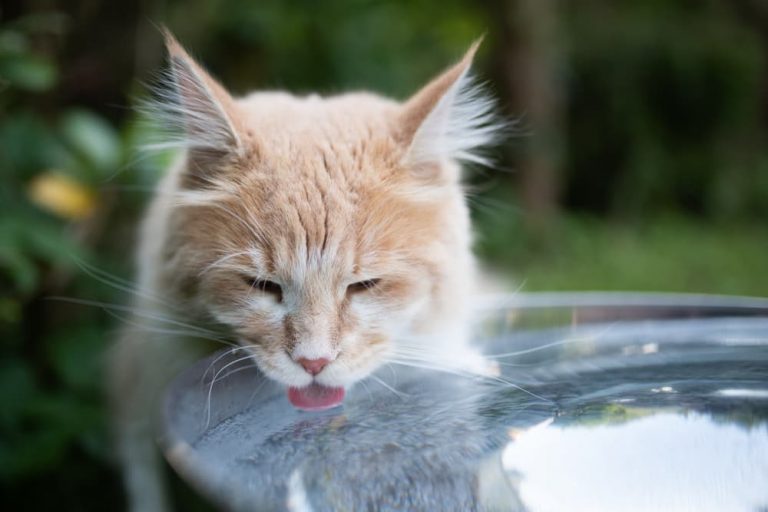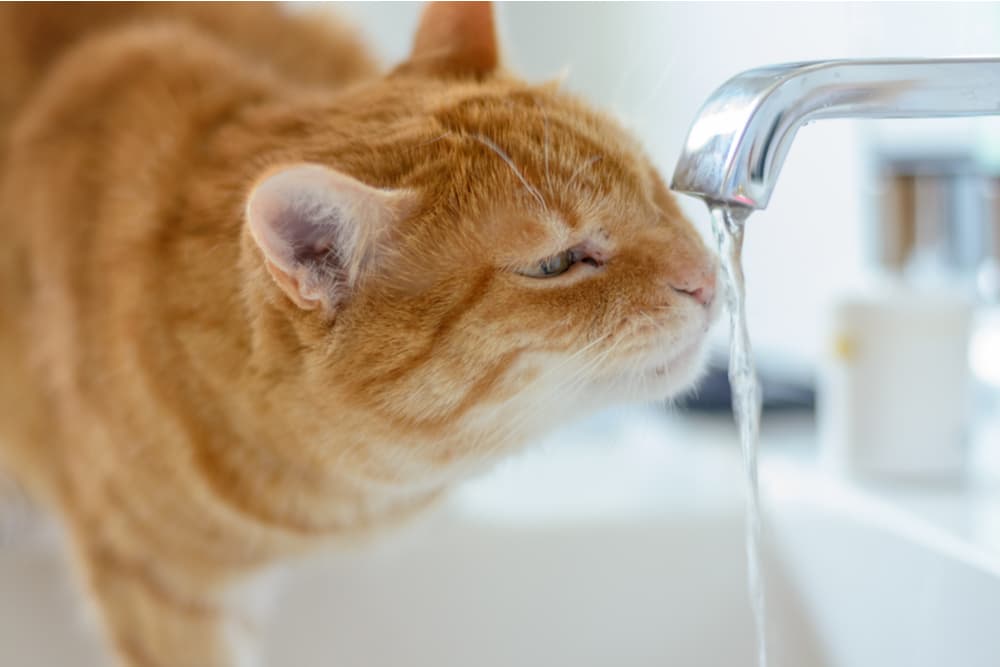Why is My Cat Drinking a Lot of Water?

Cats are not big water drinkers—they need half as much water as dogs per pound of body weight. When you notice your cat drinking a lot of water, or maybe even downing it and begging for more, it may be a red flag.
How much water is too much? What causes your cat to drink so much water? And, more importantly, what should you do about it? Read on for answers.
Why Is My Cat Drinking a Lot of Water? Common Causes

There are many health-related reasons cats will drink too much water. Polydipsia, the name of the condition for excessive water consumption, has three common causes:
Chronic Kidney Disease
Around 1-3% of all cats have chronic kidney disease. Over time kidneys become more and more damaged. Kidneys are partly responsible for maintaining your cat’s balance of water. When kidneys are damaged, they cannot hold onto water like they should. Instead, all of the water goes into the urine. This makes your cat increasingly thirsty.
Hyperthyroidism
Up to 11% of older cats live with hyperthyroidism. The thyroid gland produces thyroid hormone, which is responsible for growth, metabolism, and impacts the brain. When the gland produces too much hormone, metabolism becomes really high and the effect on the brain can cause changes in behavior. When metabolism increases, so does thirst. Also, thyroid hormone blocks antidiuretic hormone (ADH) from interacting with the kidneys. This hormone allows the kidneys to keep water in the body and not put water into the urine. If ADH cannot interact with the kidneys, an increase in drinking and urination can occur.
Diabetes Mellitus
Around 0.5% of all cats have diabetes mellitus. Diabetes mellitus occurs when your cat does not have enough insulin. Insulin allows blood sugar (glucose) to enter the liver, muscle, and fat and provide energy. If there is not enough insulin, glucose gets increasingly high with nowhere to go. The kidneys push glucose into the urine, and through osmosis, water follows glucose to dilute the urine. Since your cat produces too much urine to rid the body of glucose, she becomes very thirsty.
If your cat is diagnosed with diabetes, their treatment plan may include insulin injections. However, some cats may be candidates for a needle-free alternative to insulin called Bexacat, a once-daily flavored tablet.

Less Common Causes

Liver disease. Problems with the liver can occur for several reasons, including viral, bacterial, fungal, parasitic, inflammatory, or cancerous reasons. With severe liver disease, your liver struggles to function normally, which can affect water intake. For example, the liver stops making urea which normally allows the kidneys to retain water.
Medications. Many medications affect thirst and urination. Common medications include steroids (such as prednisolone), phenobarbital (used for seizures), or diuretics (used to decrease body water for conditions like congestive heart failure).
Hypercalcemia. Many conditions can cause too high of calcium in a cat’s body such as chronic kidney disease, vitamin D toxicity, and cancer. When calcium is very high, it prevents ADH from interacting with the kidneys. This prevents the kidneys from keeping water in the body, so an increase in drinking and urination can occur.
Cancer. Since cancer is abnormal growth of cells in the body, it can affect the way organs work. When organs aren’t functioning properly, it can cause the body to be unbalanced and result in changes such as increased thirst.
Pyometra. This condition is an infection of the uterus. If your cat is not spayed, she may develop this common condition (which does not always result in polydipsia). Pus fills the uterus and often leaks outside of the body through the vulva. The reason pyometra causes polydipsia (due to polyuria) is uncertain.
How Much Water Should a Cat Drink?

Cats typically drink 18 to 27 mL of water per pound of body weight per day. An average 10-pound cat drinks approximately 180 to 270 mL of water per day, which is equivalent to around ¾ to 1 cup of water each day.
Each individual cat will vary in how much water they need to drink, and what is normal for your cat may fall a little outside this range.
Factors that could alter how much water is required include:
Diet. Canned cat food has water content already, so your cat will drink a little less if they eat a wet food. Also, diets high in sodium require more water.
Environment. Warmer months or higher humidity require more water to stay hydrated, especially if your cat is active.
Age. Very young cats drink more than adults. Young kittens under 8 weeks of age require as much as 80 mL of water per pound of body weight!
Health. If your cat has a medical condition, she may need to drink more water to stay hydrated.
Medications. Certain medications increase thirst and/or urine output in cats.
If you are reading this article because you are concerned with how much your cat is drinking, try measuring out the amount of water you put in the bowl each morning. The next morning, measure how much is left (wait until 24 hours have passed). Be sure to never limit the amount of water your cat wishes to drink! She must always have access to as much water as she wants.
How Much Water Is Too Much?

Polydipsia is the condition of a cat drinking too much water. It is usually caused by polyuria, meaning your cat’s body is producing more urine and needs more water to do so. Shorthand for these two cat health conditions is PU/PD.
Cats vary in how much water they drink day to day. If your kitty is particularly thirsty one day (maybe due to running around on a hot summer day), the next day her drinking would be less. This would be normal variation and no reason to worry.
But if your cat is consistently (each day) drinking more than 45 mL per pound of body weight per day, she likely has polydipsia. A 10-pound cat would need to drink more than 450 mL of water per day to have polydipsia, or about 2 cups.
You may not notice a subtle increase in your cat’s water drinking, but look for signs like:
- An empty water bowl more frequently
- Waiting by the water bowl for more, meowing until it’s refilled
- Drinking an entire water bowl or most of one in one sitting
- Larger volume of urine in the cat litter box (bigger clumps and/or higher number of them)
- Urine outside of the cat litter box
What to Do When Your Cat Is Drinking Too Much Water

If you suspect your cat is drinking too much water, measure it out as described earlier in this article and keep a log of how much water your cat is drinking.
On your log record any changes in your cat’s behavior or health. Ask, has your cat’s:
- Activity decreased?
- Appetite changed?
- Weight changed?
- Urine color changed?
- Amount of urine changed?
- Diet changed lately?
- Medication regimen changed?
- Behavior changed?
If your cat is consistently drinking more than 45 mL of water per pound of body weight each day, or if you notice any other signs such as decreased activity, increased appetite, and decreased weight you should bring your cat to the veterinarian as soon as possible.
What to Expect at the Vet

Your veterinarian will examine your cat and ask many questions. Before you go, make sure you have answers to the questions above and record how much water your cat is drinking. This will help your vet get a more complete view of the situation.
Without running tests, your veterinarian is unlikely to be able to diagnose the exact cause of your cat’s excessive drinking. Bloodwork is a standard first step along with testing the urine, including a culture to look for infection. Oftentimes your veterinarian will recommend thyroid testing on the bloodwork as well.
These initial tests will almost always diagnose the issue. But if the tests don’t reveal an answer, your vet may recommend X-rays to look for pyometra (if your cat is an un-spayed female) or cancer. Your vet may perform other specific blood tests such as bile acids to assess liver function, fructosamine levels to evaluate for diabetes, leptospirosis testing, and various other hormone tests to help reach a conclusion.









